国际学术交流英语汇报
- 格式:pptx
- 大小:13.11 MB
- 文档页数:35
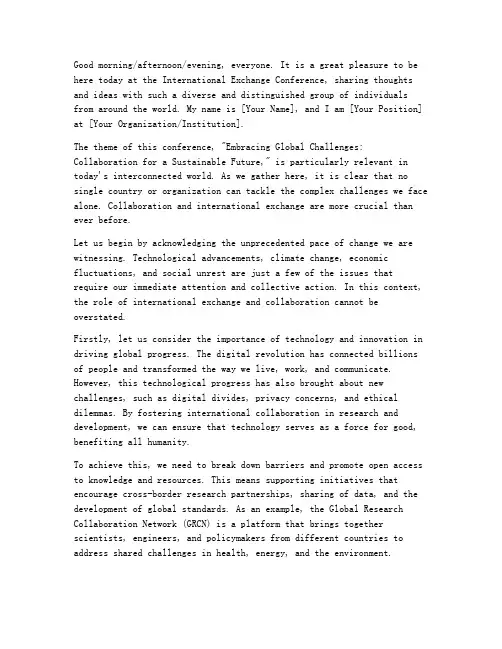
Good morning/afternoon/evening, everyone. It is a great pleasure to be here today at the International Exchange Conference, sharing thoughts and ideas with such a diverse and distinguished group of individuals from around the world. My name is [Your Name], and I am [Your Position] at [Your Organization/Institution].The theme of this conference, "Embracing Global Challenges: Collaboration for a Sustainable Future," is particularly relevant in today's interconnected world. As we gather here, it is clear that no single country or organization can tackle the complex challenges we face alone. Collaboration and international exchange are more crucial than ever before.Let us begin by acknowledging the unprecedented pace of change we are witnessing. Technological advancements, climate change, economic fluctuations, and social unrest are just a few of the issues that require our immediate attention and collective action. In this context, the role of international exchange and collaboration cannot be overstated.Firstly, let us consider the importance of technology and innovation in driving global progress. The digital revolution has connected billions of people and transformed the way we live, work, and communicate. However, this technological progress has also brought about new challenges, such as digital divides, privacy concerns, and ethical dilemmas. By fostering international collaboration in research and development, we can ensure that technology serves as a force for good, benefiting all humanity.To achieve this, we need to break down barriers and promote open access to knowledge and resources. This means supporting initiatives that encourage cross-border research partnerships, sharing of data, and the development of global standards. As an example, the Global Research Collaboration Network (GRCN) is a platform that brings together scientists, engineers, and policymakers from different countries to address shared challenges in health, energy, and the environment.Secondly, climate change is perhaps the most pressing issue of our time. The impacts of global warming are already being felt around the world, leading to extreme weather events, rising sea levels, and the loss of biodiversity. To combat this crisis, we must work together to reduce greenhouse gas emissions, adapt to the changing climate, and promote sustainable practices.International cooperation in this area is essential. The Paris Agreement, for instance, is a landmark agreement that commits countries to take action on climate change. However, achieving the goals set forth in the agreement requires continued dialogue, coordination, and financial support. We must also focus on capacity-building and knowledge transfer, ensuring that developing countries have the resources and expertise to adapt to climate change.Thirdly, economic inequality and social unrest are growing concerns. The global economic landscape is characterized by a widening gap between the rich and the poor, with marginalized communities often bearing the brunt of economic downturns. To address this issue, we need to promoteinclusive growth, support fair trade practices, and invest in education and social welfare.International exchange and collaboration can play a significant role in fostering economic stability and social cohesion. For instance, the International Labor Organization (ILO) works to promote decent work for all and social justice. By sharing best practices and resources, countries can learn from each other and develop policies that benefit their citizens.In addition to these challenges, we must also recognize the importanceof cultural exchange and understanding. The world is becomingincreasingly diverse, and it is crucial that we appreciate and respect the cultures of others. By promoting dialogue and mutual understanding, we can build bridges of trust and cooperation, reducing the likelihoodof conflict and misunderstanding.To conclude, the International Exchange Conference provides us with a unique opportunity to reflect on the role of collaboration in addressingglobal challenges. As we move forward, I would like to propose the following recommendations:1. Strengthen international partnerships and collaborations in research, development, and innovation.2. Support the implementation of the Paris Agreement and other global agreements on climate change.3. Promote inclusive growth, fair trade practices, and social welfare policies.4. Foster cultural exchange and mutual understanding to build a more peaceful and interconnected world.In closing, I would like to express my gratitude to the organizers of this conference for bringing us together. Let us leave here today with a renewed commitment to work together, share our knowledge, and create a sustainable future for all.Thank you.。
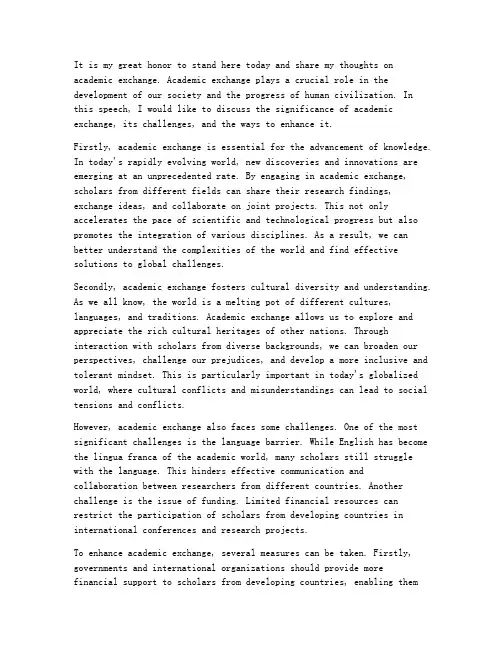
It is my great honor to stand here today and share my thoughts on academic exchange. Academic exchange plays a crucial role in the development of our society and the progress of human civilization. Inthis speech, I would like to discuss the significance of academic exchange, its challenges, and the ways to enhance it.Firstly, academic exchange is essential for the advancement of knowledge. In today's rapidly evolving world, new discoveries and innovations are emerging at an unprecedented rate. By engaging in academic exchange, scholars from different fields can share their research findings, exchange ideas, and collaborate on joint projects. This not only accelerates the pace of scientific and technological progress but also promotes the integration of various disciplines. As a result, we can better understand the complexities of the world and find effective solutions to global challenges.Secondly, academic exchange fosters cultural diversity and understanding. As we all know, the world is a melting pot of different cultures, languages, and traditions. Academic exchange allows us to explore and appreciate the rich cultural heritages of other nations. Through interaction with scholars from diverse backgrounds, we can broaden our perspectives, challenge our prejudices, and develop a more inclusive and tolerant mindset. This is particularly important in today's globalized world, where cultural conflicts and misunderstandings can lead to social tensions and conflicts.However, academic exchange also faces some challenges. One of the most significant challenges is the language barrier. While English has become the lingua franca of the academic world, many scholars still struggle with the language. This hinders effective communication andcollaboration between researchers from different countries. Another challenge is the issue of funding. Limited financial resources canrestrict the participation of scholars from developing countries in international conferences and research projects.To enhance academic exchange, several measures can be taken. Firstly, governments and international organizations should provide morefinancial support to scholars from developing countries, enabling themto participate in international academic events and collaborate with their counterparts. Secondly, efforts should be made to promote multilingualism in academic research. Encouraging scholars to publish their work in multiple languages can help bridge the language gap and facilitate global collaboration. Lastly, academic institutions should create a more inclusive and supportive environment for scholars from diverse backgrounds. This can be achieved by implementing policies that promote diversity, equity, and inclusion.In conclusion, academic exchange is a powerful tool for promoting knowledge, fostering cultural diversity, and advancing human civilization. By addressing the challenges and taking appropriate measures to enhance academic exchange, we can create a more interconnected and harmonious world. Let us all join hands and work together to promote academic exchange and contribute to the betterment of our society.Thank you for your attention.。
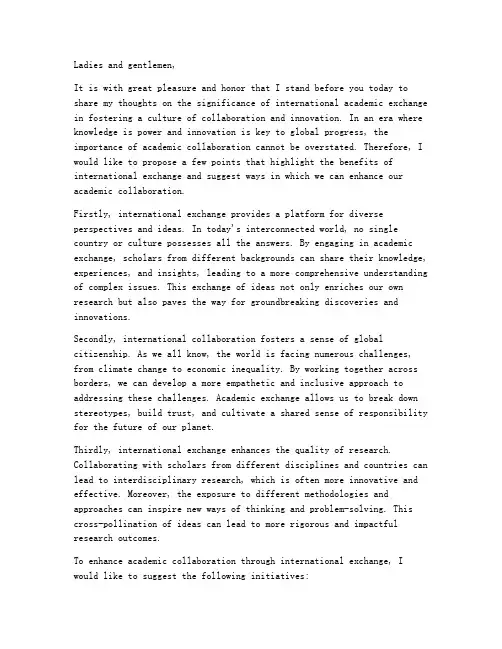
Ladies and gentlemen,It is with great pleasure and honor that I stand before you today to share my thoughts on the significance of international academic exchange in fostering a culture of collaboration and innovation. In an era where knowledge is power and innovation is key to global progress, the importance of academic collaboration cannot be overstated. Therefore, I would like to propose a few points that highlight the benefits of international exchange and suggest ways in which we can enhance our academic collaboration.Firstly, international exchange provides a platform for diverse perspectives and ideas. In today's interconnected world, no single country or culture possesses all the answers. By engaging in academic exchange, scholars from different backgrounds can share their knowledge, experiences, and insights, leading to a more comprehensive understanding of complex issues. This exchange of ideas not only enriches our own research but also paves the way for groundbreaking discoveries and innovations.Secondly, international collaboration fosters a sense of global citizenship. As we all know, the world is facing numerous challenges, from climate change to economic inequality. By working together across borders, we can develop a more empathetic and inclusive approach to addressing these challenges. Academic exchange allows us to break down stereotypes, build trust, and cultivate a shared sense of responsibility for the future of our planet.Thirdly, international exchange enhances the quality of research. Collaborating with scholars from different disciplines and countries can lead to interdisciplinary research, which is often more innovative and effective. Moreover, the exposure to different methodologies and approaches can inspire new ways of thinking and problem-solving. This cross-pollination of ideas can lead to more rigorous and impactful research outcomes.To enhance academic collaboration through international exchange, I would like to suggest the following initiatives:1. Establishing formal and informal networks: Creating platforms for scholars to connect and collaborate, such as international conferences, workshops, and seminars, can facilitate the exchange of ideas and promote long-term partnerships.2. Promoting joint research projects: Encouraging institutions to collaborate on joint research projects can help bridge the gap between different academic communities and encourage the sharing of resources and expertise.3. Developing funding mechanisms: Establishing funding opportunities specifically for international academic exchange can make it more accessible for scholars to engage in collaborative research.4. Providing language and cultural training: Ensuring that scholars are equipped with the necessary language and cultural skills to work effectively in an international environment can help overcome communication barriers and facilitate smoother collaboration.5. Fostering mentorship programs: Pairing junior scholars with more experienced mentors from different countries can provide valuable guidance and support, helping to develop the next generation of global scholars.In conclusion, international academic exchange is a powerful tool for promoting collaboration, innovation, and global citizenship. By embracing the diversity of ideas and experiences that come with international collaboration, we can contribute to a more sustainable, equitable, and prosperous future for all. Let us work together to create a world where knowledge and expertise are shared freely, and where academic collaboration knows no boundaries.Thank you for your attention, and I look forward to a lively discussion on this important topic.。
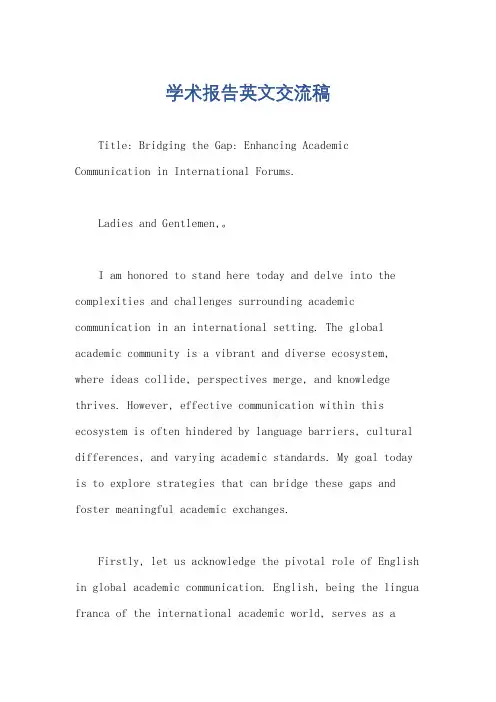
学术报告英文交流稿Title: Bridging the Gap: Enhancing Academic Communication in International Forums.Ladies and Gentlemen,。
I am honored to stand here today and delve into the complexities and challenges surrounding academic communication in an international setting. The global academic community is a vibrant and diverse ecosystem, where ideas collide, perspectives merge, and knowledge thrives. However, effective communication within this ecosystem is often hindered by language barriers, cultural differences, and varying academic standards. My goal today is to explore strategies that can bridge these gaps and foster meaningful academic exchanges.Firstly, let us acknowledge the pivotal role of English in global academic communication. English, being the lingua franca of the international academic world, serves as acommon ground for scholars from diverse backgrounds to share their research, findings, and insights. However, this also implies that non-native English speakers may face significant challenges in communicating their ideas effectively.To overcome these challenges, it is imperative for scholars to invest in enhancing their English proficiency. This includes mastering the language's nuances, such as grammar, vocabulary, and tone, as well as understanding cultural subtleties that influence communication. By doing so, scholars not only increase their chances of being understood but also contribute to the richness anddiversity of the academic discourse.Moreover, cultural differences can significantly impact academic communication. Each culture has its unique ways of perceiving, understanding, and expressing ideas. It is, therefore, crucial for scholars to be aware of these differences and strive to adapt their communication style to the international academic context. For instance, some cultures prefer a direct and assertive communication style,while others prefer a more indirect and collaborative approach. By being sensitive to these variations, scholars can ensure that their messages are received positively and are more likely to evoke meaningful discussions and collaborations.Furthermore, varying academic standards and norms across different regions and disciplines can createbarriers to effective communication. To address these issues, scholars need to be well-versed with the standards and expectations of the international academic community. This includes familiarity with citation styles, research methodologies, and publication requirements. By adhering to these standards, scholars ensure that their work is recognized and valued within the global academic sphere.In addition to these individual efforts, institutions and funding agencies also play a crucial role in promoting international academic communication. By providing scholarships and grants for international collaborations, these agencies encourage scholars from different backgrounds to work together and share their knowledge.Additionally, institutions can foster a culture of inclusivity and diversity by providing training and resources that help scholars develop their communication skills and understand different cultural perspectives.In conclusion, bridging the gap in academic communication requires a concerted effort from scholars, institutions, and funding agencies. By enhancing English proficiency, adapting to cultural differences, and adhering to international academic standards, we can foster meaningful academic exchanges and promote the free flow of ideas across borders. This, in turn, will lead to a more interconnected and enriched academic community, where knowledge thrives and scholars from all corners of the globe can contribute to the advancement of human understanding.Thank you for your attention. I look forward to engaging in a lively and fruitful discussion with you all.。
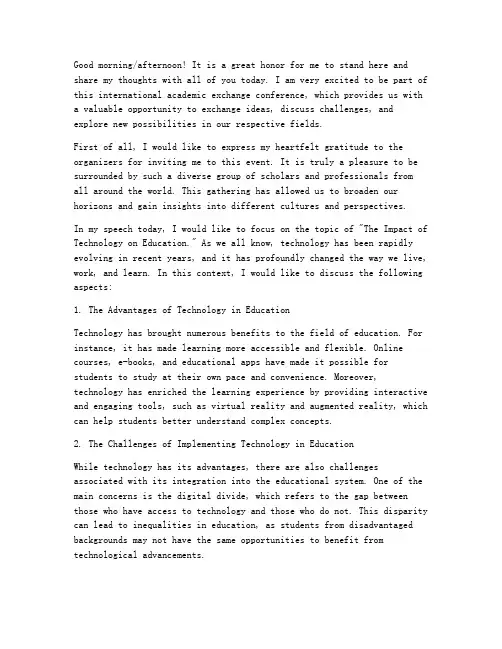
Good morning/afternoon! It is a great honor for me to stand here and share my thoughts with all of you today. I am very excited to be part of this international academic exchange conference, which provides us with a valuable opportunity to exchange ideas, discuss challenges, and explore new possibilities in our respective fields.First of all, I would like to express my heartfelt gratitude to the organizers for inviting me to this event. It is truly a pleasure to be surrounded by such a diverse group of scholars and professionals fromall around the world. This gathering has allowed us to broaden our horizons and gain insights into different cultures and perspectives.In my speech today, I would like to focus on the topic of "The Impact of Technology on Education." As we all know, technology has been rapidly evolving in recent years, and it has profoundly changed the way we live, work, and learn. In this context, I would like to discuss the following aspects:1. The Advantages of Technology in EducationTechnology has brought numerous benefits to the field of education. For instance, it has made learning more accessible and flexible. Online courses, e-books, and educational apps have made it possible for students to study at their own pace and convenience. Moreover, technology has enriched the learning experience by providing interactive and engaging tools, such as virtual reality and augmented reality, which can help students better understand complex concepts.2. The Challenges of Implementing Technology in EducationWhile technology has its advantages, there are also challenges associated with its integration into the educational system. One of the main concerns is the digital divide, which refers to the gap between those who have access to technology and those who do not. This disparity can lead to inequalities in education, as students from disadvantaged backgrounds may not have the same opportunities to benefit from technological advancements.Another challenge is the need for professional development for teachers. To effectively incorporate technology into their teaching methods, educators must be trained and equipped with the necessary skills. This requires continuous investment in teacher training programs and professional development opportunities.3. The Future of Education in the Age of TechnologyLooking ahead, the future of education seems to be increasingly intertwined with technology. As artificial intelligence, machine learning, and data analytics continue to advance, we can expect even more innovative tools and resources to be developed. These advancements will not only enhance the learning experience but also enable personalized education, where students can receive tailored instruction based on their individual needs and strengths.However, it is crucial to strike a balance between technology and traditional teaching methods. While technology can offer numerous benefits, it should not replace the essential human element in education. Teachers play a vital role in nurturing students' creativity, critical thinking, and social skills, which cannot be easily replicated by machines.In conclusion, the impact of technology on education is undeniable. It has the potential to revolutionize the way we learn and teach, but it also poses challenges that we must address. By working together, we can ensure that technology is used effectively to enhance the quality of education and bridge the gap between different groups of students.Thank you for your attention, and I look forward to engaging in further discussions with all of you during this conference.Thank you.。
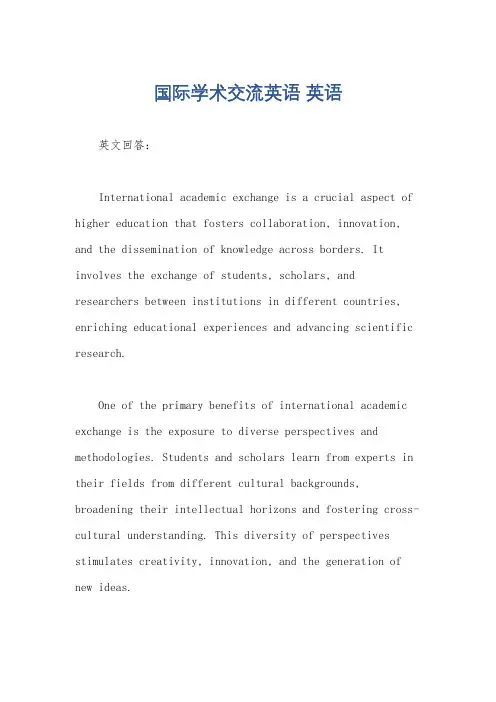
国际学术交流英语英语英文回答:International academic exchange is a crucial aspect of higher education that fosters collaboration, innovation, and the dissemination of knowledge across borders. It involves the exchange of students, scholars, and researchers between institutions in different countries, enriching educational experiences and advancing scientific research.One of the primary benefits of international academic exchange is the exposure to diverse perspectives and methodologies. Students and scholars learn from experts in their fields from different cultural backgrounds, broadening their intellectual horizons and fostering cross-cultural understanding. This diversity of perspectives stimulates creativity, innovation, and the generation of new ideas.International academic exchange also facilitates the transfer of knowledge and skills. Students and researchers gain access to specialized knowledge, cutting-edge research facilities, and advanced technologies through exchange programs. This exposure enhances their academiccapabilities and prepares them for careers in a globalized world.Furthermore, international academic exchange promotes collaboration and networking. Collaborative research projects between institutions in different countries foster interdisciplinary approaches, pooling resources and expertise to address complex global challenges. Networks established through exchange programs facilitate ongoing communication and knowledge sharing, sustaining collaboration beyond the exchange period.Cultural exchange is another significant aspect of international academic exchange. Students and scholars immersed in different cultures develop a deeper understanding of global perspectives, break down stereotypes, and foster empathy for diverse communities.This cultural exchange enriches their personal and professional lives, preparing them to thrive in an increasingly interconnected world.In conclusion, international academic exchange plays a vital role in advancing higher education and research. It promotes intellectual growth, facilitates knowledge transfer, fosters collaboration, and enhances cross-cultural understanding. By embracing international exchange, institutions create opportunities for students, scholars, and researchers to shape a more interconnected and knowledge-driven global community.中文回答:国际学术交流是高等教育中至关重要的一环,它促进了跨境合作、创新和知识传播。
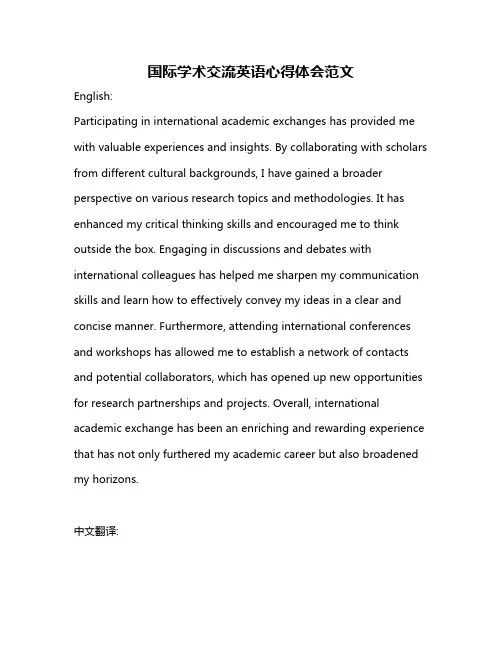
国际学术交流英语心得体会范文English:Participating in international academic exchanges has provided me with valuable experiences and insights. By collaborating with scholars from different cultural backgrounds, I have gained a broader perspective on various research topics and methodologies. It has enhanced my critical thinking skills and encouraged me to think outside the box. Engaging in discussions and debates with international colleagues has helped me sharpen my communication skills and learn how to effectively convey my ideas in a clear and concise manner. Furthermore, attending international conferences and workshops has allowed me to establish a network of contacts and potential collaborators, which has opened up new opportunities for research partnerships and projects. Overall, international academic exchange has been an enriching and rewarding experience that has not only furthered my academic career but also broadened my horizons.中文翻译:参与国际学术交流为我提供了宝贵的经验和见解。
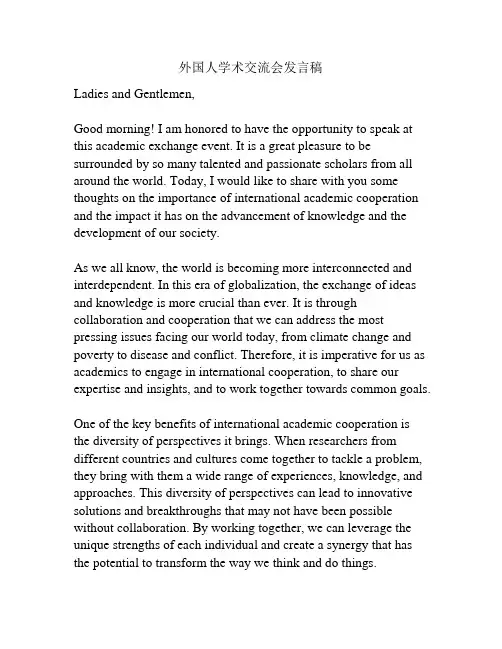
外国人学术交流会发言稿Ladies and Gentlemen,Good morning! I am honored to have the opportunity to speak at this academic exchange event. It is a great pleasure to be surrounded by so many talented and passionate scholars from all around the world. Today, I would like to share with you some thoughts on the importance of international academic cooperation and the impact it has on the advancement of knowledge and the development of our society.As we all know, the world is becoming more interconnected and interdependent. In this era of globalization, the exchange of ideas and knowledge is more crucial than ever. It is through collaboration and cooperation that we can address the most pressing issues facing our world today, from climate change and poverty to disease and conflict. Therefore, it is imperative for us as academics to engage in international cooperation, to share our expertise and insights, and to work together towards common goals. One of the key benefits of international academic cooperation is the diversity of perspectives it brings. When researchers from different countries and cultures come together to tackle a problem, they bring with them a wide range of experiences, knowledge, and approaches. This diversity of perspectives can lead to innovative solutions and breakthroughs that may not have been possible without collaboration. By working together, we can leverage the unique strengths of each individual and create a synergy that has the potential to transform the way we think and do things.Another important aspect of international academic cooperation is the opportunity it provides for capacity building and skill development. By collaborating with colleagues from different parts of the world, we can learn new methodologies, gain new insights, and acquire new skills that can enrich our own research and teaching. This can also help to bridge the gap between developed and developing countries, as it provides an avenue for the transfer of knowledge and expertise that can empower researchers and educators in less developed regions.Moreover, international academic cooperation can also lead to increased research productivity and impact. By working with colleagues from different countries, we can access new resources, facilities, and funding opportunities that may not be available in our own countries. This can enable us to conduct more ambitious and high-impact research projects, and to reach a wider audience with our findings. In addition, collaboration with researchers from other countries can also enhance the visibility and credibility of our work, as it can lead to co-authored publications, presentations at international conferences, and other forms of scholarly communication.Of course, international academic cooperation is not without its challenges. One of the main challenges is the language barrier, as not all researchers are proficient in English, which is the dominant language of academic communication. This can hinder effective collaboration and communication, and it can also lead to the marginalization of researchers from non-English speaking countries. Therefore, it is important for us to be mindful of this issue, and to actively work towards creating more inclusive andequitable research environments.Another challenge is the cultural and institutional differences that exist between countries, which can impact the way research is conducted and disseminated. This can lead to misunderstandings, conflicts, and power imbalances within collaborations, and it can also create barriers to the dissemination and application of research findings. Therefore, it is important for us to be sensitive to these differences, and to work towards building trust, understanding, and mutual respect in our collaborative endeavors.In conclusion, international academic cooperation is a powerful tool for advancing knowledge and addressing global challenges. It enables us to access a diversity of perspectives, to build our capacity and skills, to increase our research productivity and impact, and to foster understanding and collaboration across borders. However, it also poses challenges that we must be mindful of and actively work to overcome. By embracing international academic cooperation and striving to create more inclusive and equitable research environments, we can harness the collective wisdom and creativity of scholars from all around the world, and make a meaningful contribution to the betterment of our society. Thank you.。
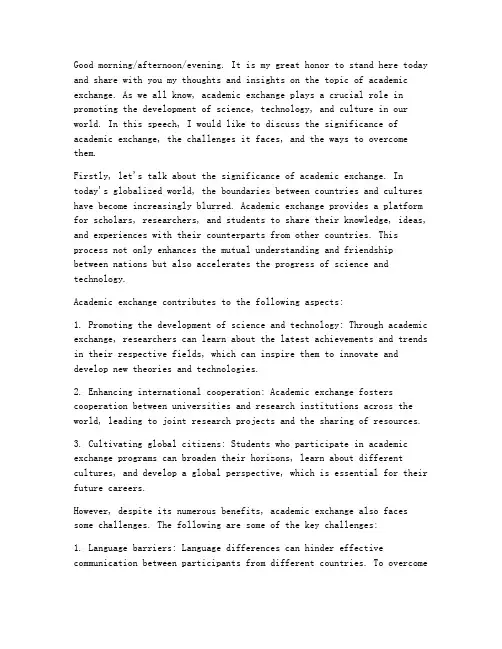
Good morning/afternoon/evening. It is my great honor to stand here today and share with you my thoughts and insights on the topic of academic exchange. As we all know, academic exchange plays a crucial role in promoting the development of science, technology, and culture in our world. In this speech, I would like to discuss the significance of academic exchange, the challenges it faces, and the ways to overcome them.Firstly, let's talk about the significance of academic exchange. In today's globalized world, the boundaries between countries and cultures have become increasingly blurred. Academic exchange provides a platform for scholars, researchers, and students to share their knowledge, ideas, and experiences with their counterparts from other countries. This process not only enhances the mutual understanding and friendship between nations but also accelerates the progress of science and technology.Academic exchange contributes to the following aspects:1. Promoting the development of science and technology: Through academic exchange, researchers can learn about the latest achievements and trends in their respective fields, which can inspire them to innovate and develop new theories and technologies.2. Enhancing international cooperation: Academic exchange fosters cooperation between universities and research institutions across the world, leading to joint research projects and the sharing of resources.3. Cultivating global citizens: Students who participate in academic exchange programs can broaden their horizons, learn about different cultures, and develop a global perspective, which is essential for their future careers.However, despite its numerous benefits, academic exchange also faces some challenges. The following are some of the key challenges:1. Language barriers: Language differences can hinder effective communication between participants from different countries. To overcomethis challenge, it is essential to provide language training and translation services.2. Cultural differences: Cultural differences can lead to misunderstandings and conflicts among participants. It is crucial to promote cultural awareness and respect among individuals involved in academic exchange.3. Financial constraints: Many scholars and students may find itdifficult to afford the costs associated with academic exchange programs, such as travel expenses, accommodation, and tuition fees. This barrier needs to be addressed through scholarships, grants, and other funding mechanisms.To ensure the success of academic exchange, the following strategies can be adopted:1. Strengthening language and cultural training: Providing comprehensive language and cultural training can help participants overcome communication barriers and adapt to the new environment.2. Enhancing funding opportunities: Establishing scholarships, grants, and financial aid programs can make academic exchange more accessible to a broader range of individuals.3. Promoting international partnerships: Encouraging universities and research institutions to establish partnerships can facilitate joint research projects and academic exchange programs.4. Utilizing technology: Leveraging technology, such as online collaboration tools and virtual conferences, can make academic exchange more accessible and efficient.In conclusion, academic exchange is a powerful tool for promoting the development of science, technology, and culture. By addressing the challenges and implementing effective strategies, we can create a more inclusive and collaborative global academic community. Let us all work together to harness the potential of academic exchange and contribute to the betterment of our world.Thank you for your attention.。
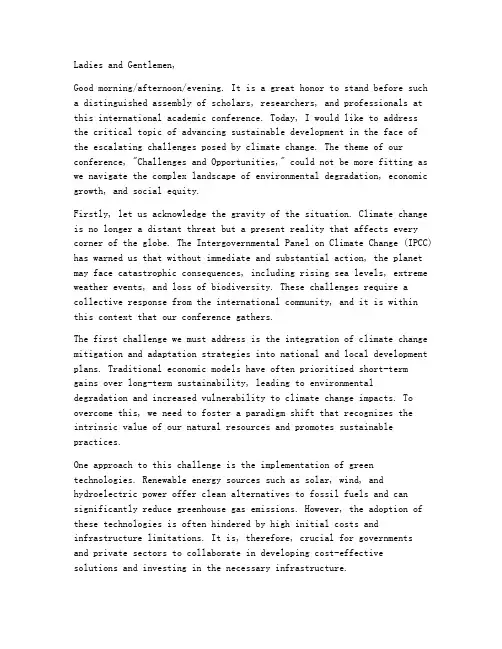
Ladies and Gentlemen,Good morning/afternoon/evening. It is a great honor to stand before such a distinguished assembly of scholars, researchers, and professionals at this international academic conference. Today, I would like to address the critical topic of advancing sustainable development in the face of the escalating challenges posed by climate change. The theme of our conference, "Challenges and Opportunities," could not be more fitting as we navigate the complex landscape of environmental degradation, economic growth, and social equity.Firstly, let us acknowledge the gravity of the situation. Climate change is no longer a distant threat but a present reality that affects every corner of the globe. The Intergovernmental Panel on Climate Change (IPCC) has warned us that without immediate and substantial action, the planet may face catastrophic consequences, including rising sea levels, extreme weather events, and loss of biodiversity. These challenges require a collective response from the international community, and it is within this context that our conference gathers.The first challenge we must address is the integration of climate change mitigation and adaptation strategies into national and local development plans. Traditional economic models have often prioritized short-term gains over long-term sustainability, leading to environmentaldegradation and increased vulnerability to climate change impacts. To overcome this, we need to foster a paradigm shift that recognizes the intrinsic value of our natural resources and promotes sustainable practices.One approach to this challenge is the implementation of green technologies. Renewable energy sources such as solar, wind, and hydroelectric power offer clean alternatives to fossil fuels and can significantly reduce greenhouse gas emissions. However, the adoption of these technologies is often hindered by high initial costs and infrastructure limitations. It is, therefore, crucial for governmentsand private sectors to collaborate in developing cost-effectivesolutions and investing in the necessary infrastructure.Another key challenge is the equitable distribution of resources and benefits. The effects of climate change are not felt equally across different regions and populations. Vulnerable communities, often the least responsible for climate change, are the most affected by its impacts. To address this, we must prioritize sustainable development goals that ensure no one is left behind. This involves creatinginclusive policies that empower marginalized groups, investing in education and capacity building, and fostering local leadership in climate adaptation and mitigation efforts.In addition to the above challenges, we must also grapple with the issue of data and knowledge sharing. Climate change is a global issue that requires a global response. However, there is often a lack of access to accurate and timely data, particularly in developing countries. To overcome this, we must strengthen international cooperation and support the establishment of regional and national climate research centers. These centers can help disseminate knowledge, provide technical assistance, and facilitate the exchange of best practices.Moving forward, there are several opportunities that can help us advance sustainable development in the face of climate change. One such opportunity lies in the emerging field of climate finance. As the Paris Agreement recognizes, developed countries have a responsibility to provide financial and technological support to developing nations in their efforts to mitigate and adapt to climate change. This support can be channeled through various mechanisms, including grants, loans, and investment in green technologies.Another opportunity arises from the growing recognition of the importance of nature-based solutions. Ecosystems such as forests, wetlands, and mangroves play a crucial role in regulating climate, preserving biodiversity, and providing essential services to human communities. By restoring and protecting these natural assets, we can enhance resilience to climate change and create jobs in the process. This approach aligns with the concept of the green economy, which promotes economic growth that is environmentally sustainable, socially inclusive, and equitable.In conclusion, advancing sustainable development in the era of climate change is a complex and multifaceted endeavor. It requires a combination of political will, technological innovation, and social commitment. As we navigate the challenges ahead, we must remember that theopportunities for a sustainable future are abundant, provided we act with urgency and determination.Ladies and Gentlemen,In closing, I would like to emphasize that the solutions to our climate change challenges lie within our reach. It is through the collective wisdom and expertise of this conference that we can identify and implement strategies that will pave the way for a more sustainable and resilient future. Let us not underestimate the power of collaboration and knowledge sharing. Together, we can make a difference.Thank you for your attention, and I look forward to engaging in meaningful discussions with all of you throughout this conference.[Your Name]。
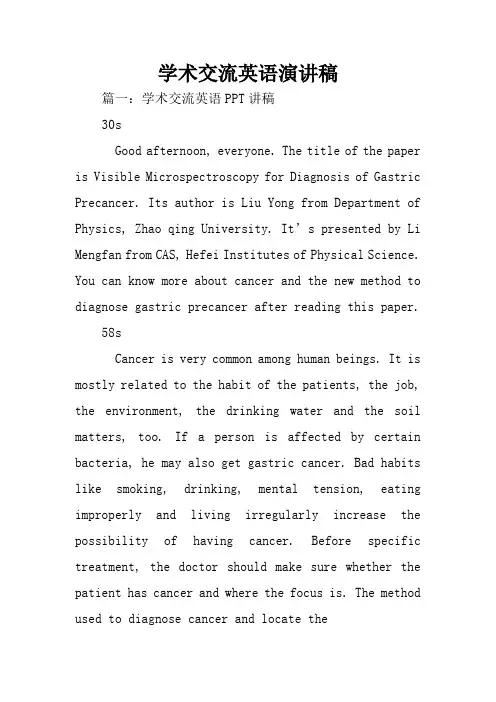
学术交流英语演讲稿篇一:学术交流英语PPT讲稿30sGood afternoon, everyone. The title of the paper is Visible Microspectroscopy for Diagnosis of Gastric Precancer. Its author is Liu Yong from Department of Physics, Zhao qing University. It’s presented by Li Mengfan from CAS, Hefei Institutes of Physical Science. You can know more about cancer and the new method to diagnose gastric precancer after reading this paper.58sCancer is very common among human beings. It is mostly related to the habit of the patients, the job, the environment, the drinking water and the soil matters, too. If a person is affected by certain bacteria, he may also get gastric cancer. Bad habits like smoking, drinking, mental tension, eating improperly and living irregularly increase the possibility of having cancer. Before specific treatment, the doctor should make sure whether the patient has cancer and where the focus is. The method used to diagnose cancer and locate thecancerous area is very important.42sBefore we design a method to diagnose cancer, we should know more about cancer like where it starts and what it causes. Firstly, about 90% of the human’s cancer start from the epithelial layer of skin, internal organs and tubular organs in the body. Secondly , cancer usually accompanied by the changes of organization structure in the cell level. So, the changes which appear in the structure of organization and chemical composition provides important evidence for diagnosis of precancer.42sNormal method to diagnose gastric precancer is Reflectance spectroscopy. It’s very prospective in early diagnosis of cancer and is commonly used these years.One of the most common technology is diffuse reflectance visible spectroscopy, it can acquire the approximate information of the target tissue. This method is low cost, fast and non-invasive, it provides important means for diagnosis of malignant damage oforganization of human organs. However, there are also some disadvantages of this method which need to be improved.55sThis is the system of diffuse reflectance spectroscopy, the light beam emitted from the tungsten halogen lamp is guided into the integral ball by the source fiber. The light come out of the integral ball irradiate the standard board, the reflected light of the standard board is treated as the background. Then take target tissue substitute for the standard board, and scan the reflected light of it. The reflected light spectra of the gastric tissue mucosal layer and the submucosa layer is guided into the spectrometer by the collector fiber. The spectrometer and the computer is connected by USB, spectrum can be processed using computer.36sFirst of all, only average visible spectrum of the target tissue can be acquired, it means that the docters cannot make out the location of the cancerous tissue precisely.What’s more, the device is easy to be affected by changes of optical path length induced by different set-up of prober and the variation of hemoglobin concentration due to the pressure between prober and tissue.50sTo avoid the problems of the commonly used techniques, diffuse reflectance visible spectroscopy, scientists do a lot of researches to find out a new way to diagnose precancer.The new method is Visible Microspectroscopy. The visible microspectroscopic measurement device is accomplished on the basis of fiber confocal microscope, its 3-d imaging principle devote to the optical tomography ability of the system.The visible microspectrum of cancerous and normal tissue can be analysed and contrasted, so it’s more useful than the normal method.45sThis is the structure of the visible microspectroscopy device .The fiber coupler can separate the lighting beamsfrom the signal beam. The two lens can focus the light on the tissue ,The 3-D electronic controlled platform move along the direction of optic axis, so that the device can acquire the visible microspectroscopy signal of the sample in different depth, precisely locate the boundary of the cancerous signal measured from different position can be stored in the computer after analysed by the spectrometer.31sThis is the spectrum chart of the normal tissue and cancerous tissue, they are analyzed by the spectrometer before being transmitted to the computer. The upper chart is the visible spectrum of normal tissue, it is regular. Contrasting to this, in the nether chart, the spectrum of the cancerous area shows that the strength of reflected light grows as the wave length grows.49s篇二:大学生学术交流演讲稿演讲稿各位同学,老师大家好!我是。
Good morning/afternoon/evening. It is a great honor to stand here today and have the opportunity to share my thoughts and research findings with all of you. I would like to thank the organizing committee for inviting me to this esteemed academic conference and giving me the chance to present my work.My topic today is the impact of artificial intelligence on the future of education. In recent years, we have witnessed a rapid development of artificial intelligence technology, which has changed our lives in numerous ways. Education is no exception, as AI is beginning to play an increasingly important role in the field.Firstly, AI has the potential to personalize learning experiences for students. With the help of AI, teachers can tailor their teaching methods to the individual needs of each student, ensuring that they receive the best possible education. For instance, AI-powered learning platforms can analyze a student's learning patterns and provide customized recommendations on how to improve their performance. This not only enhances the learning experience but also helps to close the achievement gap between students from different backgrounds.Secondly, AI can assist teachers in managing large classes more efficiently. With the help of AI, teachers can automate routine tasks such as grading and attendance tracking, allowing them to focus more on teaching and student engagement. Additionally, AI can help identify students who are struggling and provide them with timely support,thereby reducing the number of students who drop out of school.Furthermore, AI can revolutionize the way we conduct research in education. By analyzing vast amounts of data, AI can identify trends and patterns that were previously hidden. This can lead to the developmentof new theories and methodologies that can improve educational practices. For example, AI can be used to predict which students are at risk of dropping out and intervene early to prevent this from happening.However, it is essential to acknowledge the challenges that come withthe integration of AI in education. One of the main concerns is the potential for bias in AI algorithms. If the data used to train thesealgorithms is biased, the AI system may produce unfair results, leading to discrimination against certain groups of students. Therefore, it is crucial to ensure that the data used to train AI systems in education is diverse and representative of the entire population.Another challenge is the need for a skilled workforce to develop and maintain AI systems in education. There is a growing demand for professionals with expertise in AI, data science, and education. To meet this demand, we need to invest in education and training programs that can prepare students for careers in these emerging fields.In conclusion, the integration of artificial intelligence in education holds immense potential to transform the field for the better. By personalizing learning experiences, enhancing teacher efficiency, and revolutionizing research, AI can contribute to a more inclusive and effective educational system. However, we must address the challenges that come with this integration, such as bias and the need for skilled professionals. Only by doing so can we ensure that AI is used responsibly and effectively in education.Thank you for your attention, and I am now open to any questions or comments you may have.。
Good morning/afternoon/evening! It is a great honor and pleasure for me to stand here before such a distinguished audience at this international academic exchange conference. Today, I would like to share my thoughts on the importance of international academic collaboration and its impact on global progress.Firstly, let me extend my warmest welcome to all the participants from various corners of the world. Your presence here today is a testament to the increasing importance of international academic exchange and cooperation. In this rapidly evolving globalized world, the need for collaboration between scholars and researchers from different countries has never been more crucial.The primary reason for the significance of international academic collaboration is the exchange of knowledge and ideas. In today's interconnected world, no single country or region possesses all the necessary expertise and resources to tackle the complex challenges we face. By collaborating with our counterparts from different countries, we can pool our collective wisdom and expertise to address these challenges more effectively.One of the most significant benefits of international academic collaboration is the acceleration of research and development. When scholars from different disciplines and cultures come together, they bring diverse perspectives and methodologies to the table. Thisdiversity fosters innovation and creativity, leading to groundbreaking discoveries and advancements in various fields. For instance, the collaboration between Western and Asian scientists in the field of genomics has led to significant breakthroughs in understanding human genetics and treating diseases.Furthermore, international academic collaboration helps to bridge the knowledge gap between developed and developing countries. Developing nations often face limitations in terms of funding, infrastructure, and access to advanced research facilities. Through partnerships with international academic institutions, these countries can gain access to the latest technologies, expertise, and resources, enabling them toleapfrog certain stages of development and contribute meaningfully to global progress.In addition to research and development, international academic collaboration plays a vital role in promoting cultural understanding and fostering global citizenship. When scholars from different cultures work together, they not only exchange academic knowledge but also learn about each other's customs, traditions, and values. This cultural exchange fosters mutual respect and appreciation, which is essential for building a peaceful and harmonious world.To ensure the success of international academic collaboration, it is essential to establish robust platforms and frameworks for cooperation. Some key strategies include:1. Strengthening academic networks: By fostering strong relationships between academic institutions worldwide, we can create a more interconnected global academic community. This can be achieved through joint research projects, exchange programs, and international conferences.2. Promoting interdisciplinary research: Encouraging scholars from different disciplines to collaborate can lead to more comprehensive and innovative solutions to complex problems. Interdisciplinary research can break down silos and encourage a holistic approach to problem-solving.3. Facilitating access to resources: Ensuring that developing countries have access to the necessary resources, including funding, research facilities, and training opportunities, is crucial for promoting international academic collaboration.4. Encouraging policy dialogue: Governments and policymakers should engage in discussions on how to support and facilitate international academic collaboration. This can involve providing financial incentives, simplifying visa procedures, and promoting open access to research findings.In conclusion, international academic collaboration is a powerful tool for advancing knowledge, fostering innovation, and promoting globalprogress. By pooling our collective resources, expertise, and perspectives, we can address the challenges of the 21st century more effectively and build a better future for all. I am confident that this conference will serve as a catalyst for further international academic collaboration and contribute to the betterment of our world.Thank you for your attention, and I would be happy to answer any questions you may have.[Your Name]。
---[Your Name][Your Institution][Date]---Ladies and Gentlemen,Good [morning/afternoon/evening]. It is a great pleasure and honor to stand before you today to share my insights and research findings on [topic of the speech]. I would like to extend my heartfelt gratitude to the organizing committee for inviting me to this esteemed conference and to all the participants for joining us in this intellectual exchange.The purpose of my presentation is to [briefly state the objective of your talk]. In today's rapidly evolving academic landscape, [topic of the speech] has emerged as a critical area of study with far-reaching implications for [field or industry]. Therefore, it is imperative that we come together to discuss, debate, and collaborate on this subject.IntroductionTo begin, let me provide a brief overview of the background and context of [topic of the speech]. Over the past few years, [mention any relevant historical or recent developments]. These developments have highlighted the need for [mention the importance of the topic].Literature ReviewIn this section, I will briefly summarize the existing literature on [topic of the speech]. It is important to acknowledge the contributions of [mention key authors or studies]. However, despite the extensive research conducted in this area, there are still [mention any gaps or unresolved issues].MethodologyTo address the gaps identified in the literature, our research team employed [mention the research methodology or tools used]. The methodology included [mention any specific steps or techniques]. This approach allowed us to [mention the outcome or results of the study].Results and DiscussionOur findings revealed [mention the key findings of the study]. These findings are significant because [explain the implications or importance of the findings]. Furthermore, our study also indicated [mention any additional insights or findings]. These results contribute to the existing body of knowledge in [field or industry].In discussing our findings, we also compared them with the existing literature and identified [mention any similarities or differences]. This comparative analysis provides a broader perspective on [topic of the speech].ConclusionIn conclusion, the findings of our study have [mention the main conclusion or implications]. These findings not only contribute to the academic discourse on [topic of the speech] but also have practical implications for [field or industry]. Moving forward, there are several directions for future research that I would like to highlight:1. [First future research direction]2. [Second future research direction]3. [Third future research direction]Closing RemarksIn closing, I would like to emphasize the importance of [topic of the speech] in [field or industry]. By fostering collaboration and knowledge sharing, we can collectively advance our understanding and address the challenges that lie ahead. I am confident that the discussions and ideas shared during this conference will inspire new research and innovative solutions.I would like to extend my appreciation to all the participants for their attention and engagement. I welcome any questions or comments you may have, and I am eager to continue the dialogue on this important topic.Thank you for your time and attention.---[Your Name][Your Institution][Contact Information]。
Good morning/afternoon! It is my great honor to stand here and sharewith you my experiences and insights from my study abroad journey. Today, I would like to talk about the significance of international exchange programs and the invaluable lessons I have learned during my time at [Name of Host University].First and foremost, I would like to express my sincere gratitude to my home university and the [Name of Host University] for providing me with this incredible opportunity. Studying abroad has been a life-changing experience that has not only expanded my academic knowledge but also enriched my personal growth.One of the most significant benefits of studying abroad is the exposure to a diverse and multicultural environment. At [Name of Host University], I had the chance to meet students from various countries and backgrounds, which broadened my perspective on the world. Through daily interactions, I learned to appreciate and understand different cultures, traditions, and ways of life. This exposure not only enhanced my global awarenessbut also taught me the importance of empathy, tolerance, and respect for others.Furthermore, studying abroad has significantly improved my language skills. The immersive environment of a foreign country forced me to step out of my comfort zone and communicate in a new language. This experience has not only helped me become more fluent in English but also enhanced my ability to adapt to new situations and learn quickly.Another crucial aspect of my study abroad experience was the academic rigor and diverse range of courses offered at [Name of Host University]. The curriculum was challenging and engaging, and I had the opportunityto explore subjects that were not available at my home university. This exposure to new fields of study not only broadened my academic horizons but also allowed me to develop critical thinking and problem-solving skills.During my time abroad, I also had the chance to participate in various extracurricular activities and join student organizations. These experiences taught me the importance of teamwork, leadership, and timemanagement. I learned to balance my academic responsibilities with personal and social commitments, which has been invaluable in preparing me for my future career.Furthermore, studying abroad has taught me the importance of resilience and adaptability. Dealing with homesickness, cultural differences, and unexpected challenges was not easy, but it made me stronger and more determined. I learned to embrace change and face difficulties head-on, which has undoubtedly shaped my character and prepared me for future challenges.In conclusion, my study abroad experience at [Name of Host University] has been incredibly rewarding. It has not only enriched my academic and personal growth but also instilled in me a sense of global citizenship.I believe that international exchange programs are essential for fostering mutual understanding and promoting peace in our increasingly interconnected world.As I return to my home university, I carry with me the memories, friendships, and lessons learned from my time abroad. I am grateful for the opportunity to have broadened my horizons and become a better version of myself. I encourage all of you to consider participating in similar programs and embrace the challenges and opportunities that come with studying abroad.Thank you for your attention, and I am open to any questions you may have.Best regards,[Your Name]。
英语作文-高等教育行业中的国际学术交流与合作研究In recent years, international academic exchange and cooperation in the higher education industry have become increasingly important. With the globalization of education and research, universities and academic institutions around the world are seeking to collaborate and share knowledge in order to advance their respective fields. In this article, we will explore the significance of international academic exchange and cooperation in the higher education industry, as well as the benefits and challenges associated with such collaboration.First and foremost, international academic exchange and cooperation play a crucial role in promoting the exchange of ideas and knowledge across borders. By collaborating with scholars and researchers from different countries, academics are able to gain new perspectives and insights that can enrich their own work. This cross-fertilization of ideas can lead to innovative research and the development of new academic theories and methodologies. Additionally, international collaboration can also facilitate the sharing of resources and expertise, which can be particularly beneficial for institutions with limited research funding or access to specialized equipment.Furthermore, international academic exchange and cooperation can contribute to the internationalization of higher education institutions. By establishing partnerships with foreign universities, colleges, and research centers, institutions can create opportunities for students and faculty to engage in international study programs, joint research projects, and academic conferences. This not only enhances the academic experience for students and faculty, but also helps to foster a global mindset and intercultural competence, which are increasingly valued in today's interconnected world.Moreover, international collaboration can also lead to the publication of high-quality research papers and academic journals. By working with international partners, researchers can access a wider pool of data and resources, which can enhance the rigorand impact of their research. Additionally, collaborative research projects can lead to co-authored publications, which can increase the visibility and influence of the researchers involved. This, in turn, can enhance the reputation and ranking of the institutions involved, leading to greater recognition and opportunities for future collaboration.Despite the numerous benefits of international academic exchange and cooperation, there are also challenges that need to be addressed. One of the main challenges is the language barrier, as not all scholars are proficient in English, which is the dominant language in academic publishing and communication. This can hinder effective communication and collaboration, and may require the use of translation services or multilingual support to facilitate exchange and cooperation.Another challenge is the differences in academic standards and practices across countries, which can lead to misunderstandings and conflicts in collaborative research projects. In order to overcome this challenge, it is important for institutions to establish clear guidelines and expectations for collaboration, as well as to foster mutual understanding and respect for diverse academic traditions and methodologies.In conclusion, international academic exchange and cooperation are essential for the advancement of knowledge and the internationalization of higher education institutions. By promoting the exchange of ideas, resources, and expertise, international collaboration can lead to innovative research, enhanced academic experiences, and the publication of high-quality research. While there are challenges that need to be addressed, the benefits of international academic exchange and cooperation far outweigh the obstacles, making it a vital component of the higher education industry.。
学术交流英文演讲稿学术交流英文演讲稿篇一:医学国际学术交流会主席发言稿英文Dear colleagues & distinguished guests:We are delighted to invite you to attend “XX International conference of Analysis of unintended events in hospitals”, December 10, XX in Shihezi University, Xinjiang, China.Since the early nineties, many studies have been performed to examine the incidence of adverse events, with reported incidence rates ranging from 3 to 17% of all hospital admissions.A quarter to half of the adverse events was considered preventable. These studies have increased the sense of urgency to take effective countermeasures in order to improve patient safety in hospitals. Improvements can only be achieved if the interventions tackle the dominant under lying causes. When examining causal factors, not only adverse events but also other unintended events are theme of the meeting is “Analysis of unintended events in hospitals”. In order to identify the causes of unintended events, there are a number of analysis tools, brought together under theumbrella term Root Cause Analysis. One common tool is causal tree analysis. Causal trees are the basis for the PRISMA (Prevention and Recovery Information System for Monitoring and Analysis)method (see below), which is becoming the standard in Dutch hospitals to analyse the root causes of unintended events and has also been used in studies abroad .The corresponding taxonomy to classify root causes .We anticipate the first international PRISMA symposium to be filled with fervent enthusiasm and active academic are very glad to seeeveryone in the yours篇二:英语国际学术交流——主持人演讲词表示欢迎:Good morning, Ladies and Gentlemen, I’m privileged to welcome you all to “Nuclear energy around us” conference.You have come all the way for this conference. Thank you very much for your attention/participation.自我介绍:Let me introduce myself I am Dr Wang from DLUT, China, and I am going to be the chair for this morning’s session.介绍议题:This conference will focus on thediscussion of the various aspects of Nuclear Energy It includes the application of nuclear energy and the Safety and Waste of Nuclear Energy .And we will also discuss the prospect of Nuclear Energy.这个会议将主要讨论有关核能的各个方面。